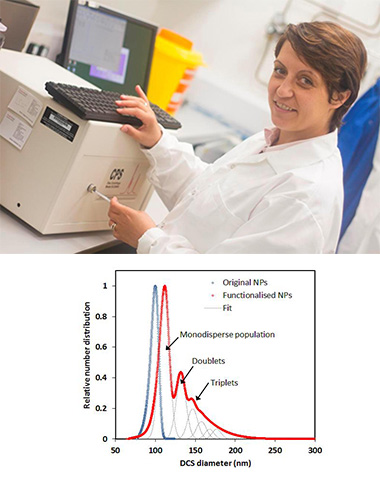Analytik reports on use of the CPS Disc Centrifuge system for measurement of size and density of nanoparticles by the Nanoanalysis Group at the National Physical Laboratory
 Analytik reports on use of the CPS Disc Centrifuge system for measurement of size and density of nanoparticles by the Nanoanalysis Group at the National Physical Laboratory
Analytik reports on use of the CPS Disc Centrifuge system for measurement of size and density of nanoparticles by the Nanoanalysis Group at the National Physical Laboratory
Cambridge, UK, 26th November 2013: Analytik, leading suppliers of innovative analytical instrumentation, report on use of the CPS Disc Centrifuge for ultra-high resolution nanoparticle size analysis by the Nanoanalysis Group of the National Physical Laboratory.
The National Physical Laboratory (NPL), the United Kingdom’s National Measurement Institute, is well equipped with many means to characterise the size of nanoparticles. These are complementary and are used in concert or alone depending on the type of materials being studied. Every particle sizing technique is based on a different physical principle and therefore measures a slightly different “size” of the nanoparticle. Take, for example, a gold nanoparticle stabilised with citrate molecules. Dynamic Light Scattering, DLS, will measure the hydrodynamic radius; that is the gold core, the molecular coating and every molecule of solvent that moves with the core. In contrast, transmission electron microscopy, TEM, measures the size of the metallic core, thus providing a size of the nanoparticle that is smaller than that measured by DLS.
The Group also uses the CPS Disc Centrifuge system from Analytik. This technique is based on differential centrifugal sedimentation. Describing this technique, Dr Caterina Minelli says: “The CPS technique is very precise and produces particle size distributions with extremely high resolution. This means that when we attach antibodies to the surface of a nanoparticle, for example, we are able to identify and quantify not only the main population of well functionalised particles, but also the fraction of undesired particles that aggregate in doublets, triplets or larger aggregates. The CPS instrument thus provides us with a means to assess the quality of a surface functionalisation protocol and supports its improvement and refinement.”
Continuing, Dr Minelli says: “Another advantage of the CPS technique is that in combination with other techniques, or with careful experiments, we can measure both the size and the density of particles. This is because the instrument measures the particle sedimentation time through a medium, which depends on both the particle size and the density. If the size of the particle is known, for example by measuring it with an independent technique, the CPS can provide a direct measurement of the particle density. When we modify the surface of a nanoparticle, for example by coating it with molecules such as proteins, we change both its size and its effective average density. The ability to measure the change in the particle density means we have a tool to characterise the molecular coating surrounding the nanoparticles. This approach is useful to study engineered nanoparticles used in biosensing. Another application involves the study of how protein corona forms at the nanoparticles’ surface as they enter a biological fluid such as blood or urine. The entity of the protein corona will determine the fate of the nanoparticles and has strong implications for nanoparticle toxicity, for example.”
With a wide variety of materials and potential users for making routine analytical particle size measurements, the CPS is particularly popular because of its versatility and ease of use. From a research perspective, the main use of the CPS is to optimise the highly engineered biomolecular coating of nanoparticles used in biosensing systems or other medical applications. This experience enables the NPL’s Nanoanalysis Group to offer contract analysis to external clients. Further details are available at http://www.npl.co.uk/science-technology/surface-and-nanoanalysis/services/nanomaterials-characterisation-techniques-for-powders-and-liquid-dispersions.
To find out more about CPS’ disc centrifuge nanoparticle characterisation systems, visit: www.analytik.co.uk/product/nanoparticle-size-analysis-cps-disc-centrifuge-uhr/.
Reference: (1) “Emerging Techniques for Submicrometer Particle Sizing Applied to Stöber Silica” by Nia C. Bell, Caterina Minelli et al., Langmuir 28 (2012) 10860; (2) “Quantitation of IgG protein adsorption to gold nanoparticles using particle size measurement” by Nia C. Bell, Caterina Minelli and Alexander G. Shard, Analytical Methods 5 (2013) 4591.
About…the National Physical Laboratory (NPL) is one of the UK’s leading science facilities and research centres. It is a world-leading centre of excellence in developing and applying the most accurate standards, science and technology available. NPL occupies a unique position as the UK’s National Measurement Institute and sits at the intersection between scientific discovery and real world application. Its expertise and original research have underpinned quality of life, innovation and competitiveness for UK citizens and business for more than a century. www.npl.co.uk.


